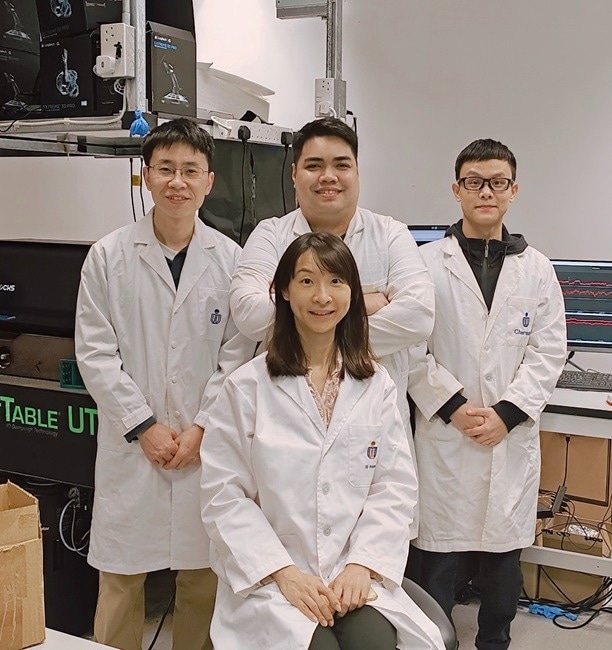The Hong Kong University of Science and Technology (HKUST)-led research team has created an optical plasmonic tweezer-controlled Surface-Enhanced Raman Spectroscopy (SERS) platform that allows for the on-and-off control of light to probe different amylin species in mixtures at the single-molecule level.
 A group photo of Prof. HUANG Jinqing (front row), and members on her research team, including then Postdoctoral Research Fellow Dr. DAI Xin (left, second row), PhD students MESIAS St. Dollente Vince (middle, second row), and FU Wenhao (right, second row) at the Department of Chemistry at HKUST. Image Credit: The Hong Kong University of Science and Technology
A group photo of Prof. HUANG Jinqing (front row), and members on her research team, including then Postdoctoral Research Fellow Dr. DAI Xin (left, second row), PhD students MESIAS St. Dollente Vince (middle, second row), and FU Wenhao (right, second row) at the Department of Chemistry at HKUST. Image Credit: The Hong Kong University of Science and Technology
This technology has revealed the heterogeneous structures of pH-dependent amylin species as well as the mysteries surrounding the amyloid aggregation mechanisms linked to type 2 diabetes.
By eliminating ensemble averaging, single-molecule methods analyze the signal sent by individual molecules, revealing previously unnoticed information and revolutionizing the understanding of intricate and diverse molecular systems. Since the diffraction-limited detection volume cannot be further decreased, current single-molecule methods are restricted to ultra-dilution and/or molecular immobilization.
Certain biomolecules, on the other hand, participate in a variety of interactions that are significantly influenced by concentration. In type II diabetes patients, for example, human Islet Amyloid Polypeptide (amylin, hIAPP) lacks stable secondary structures but has an aggregation proclivity governed by environmental factors such as concentration and pH to generate distinct oligomeric intermediates and amyloid fibrils.
Due to the difficulties in identifying the uncommon, ephemeral, and heterogeneous amylin species in a dynamic mixture, the molecular process is still unknown, necessitating the development of sophisticated single-molecule techniques.
A novel single-molecule platform that combines optical plasmonic manipulation and SERS measurement to reduce detection volume and elevate signal enhancement has recently been successfully developed by a research team led by Prof. Jinqing Huang, Assistant Professor at the Department of Chemistry at HKUST.
This development enables productive and high-throughput single-molecule characterization to study pH-dependent amylin species at physiological concentrations.
The researchers specifically created a plasmonic junction between two silica microbeads covered with Ag nanoparticles to trap an additional Ag nanoparticle and create a dynamic nanocavity that would be able to encapsulate one or more molecules for sensitive SERS characterizations.
Since SERS phenomena and optical plasmonic trapping are spatially limited on the nanometer scale, it is possible to achieve simultaneous SERS enhancement, minimal detection volume, and precise position control that exceeds the optical diffraction limit.
Furthermore, compared to traditional Ag nanoparticle assemblies in solutions, the built Ag nanoparticle-coated silica microbead dimers exhibit higher stability, facilitating the observation and localization of the plasmonic junction under standard microscopes, hence enhancing efficiency and repeatability.
The researchers can modify the construction and disassembly of the dynamic nanocavity for high-throughput sampling and simultaneous SERS measurements by varying the laser light between “on” and “off” states.
With the help of this effective single-molecule platform, researchers were able to extract a statistically significant number of SERS spectra that explained the structural characteristics of different amylin species in two different physiological settings: the extracellular compartments at pH 7.4 and the secretory granules of pancreatic β-cells at pH 5.5.
Molecular dynamics (MD) simulations confirmed the identification of two low-populated amylin species from their dominating monomers during the early stages of amyloid aggregation in neutral pH.
These species had a short β-hairpin with a restricted C-terminal or a crucial turn structure. Even when the pH is adjusted from 7.4 to 5.5, a little change in the balance between several amylin species can lead to permanent amyloid development.
As a result, the direct structural characterization of these amylin species within heterogeneous mixtures reveals the influence of pH on their intra- and inter-molecular interactions and gives information on the mechanism behind pH-regulated amyloid aggregation, which is important for understanding type 2 diabetes.
We present an easy-to-use strategy that reduces detection volume, enhances molecular signal, and increases turnover efficiency. “Our single-molecule platform can acquire a large amount of SERS spectra as molecular snapshots, comparable to those obtained through MD simulations. By statistically analyzing the structural details at the single-molecule level, we are able to reconstruct the bulk properties and gain unique insights into the population and probability of specific molecule types within the heterogeneous mixture. It has the potential to uncover hidden mysteries in complex systems.
Jinqing Huang, Assistant Professor, Department of Chemistry, The Hong Kong University of Science and Technology
Journal Reference:
Fu, W., et. al. (2023) Efficient optical plasmonic tweezer-controlled single-molecule SERS characterization of pH-dependent amylin species in aqueous milieus. Nature Communications. doi:10.1038/s41467-023-42812-3.